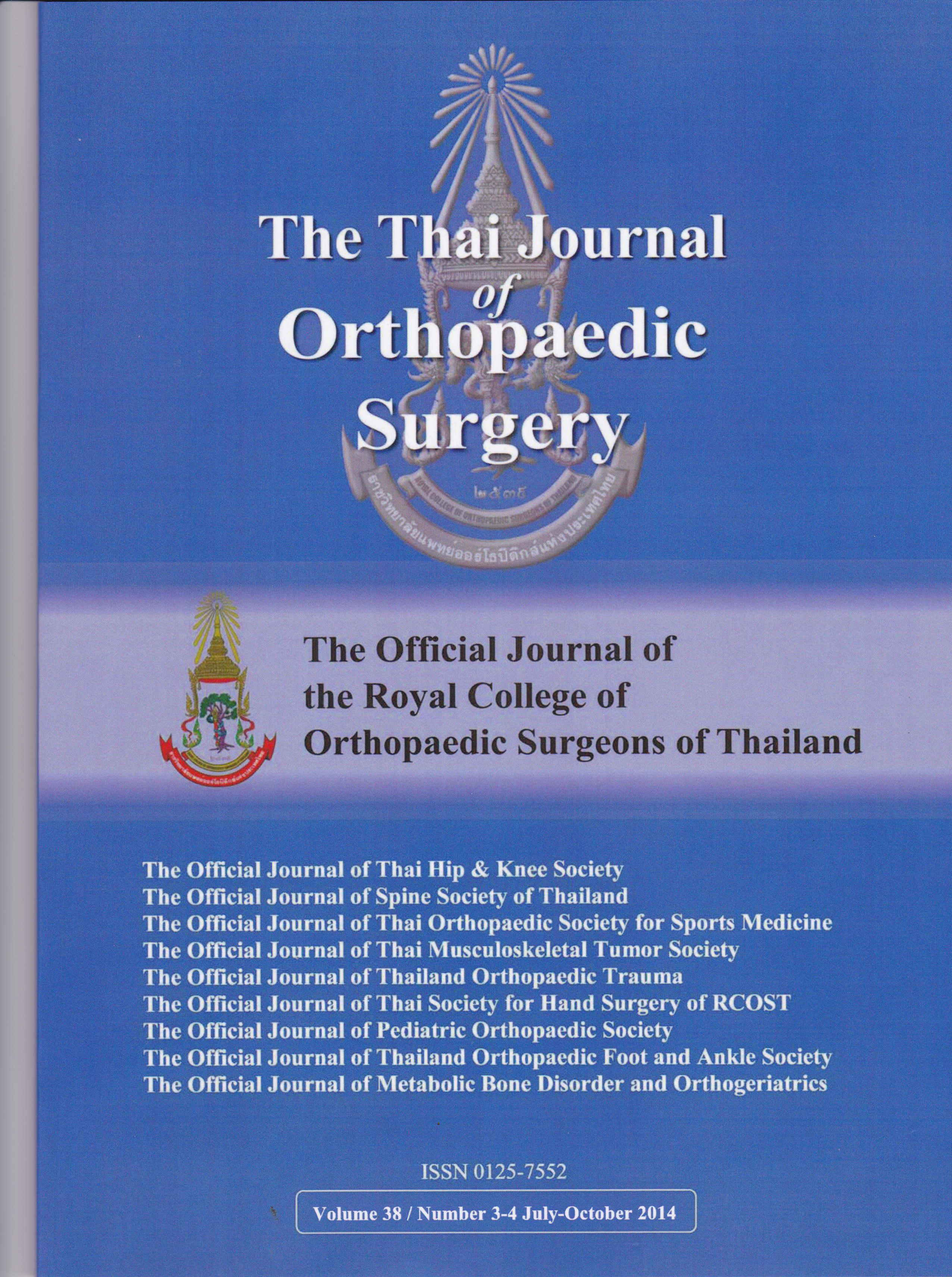การทำ complete release ของ superficial medial collateral ligament ในขณะผ่าตัดเปลี่ยนข้อเข่าเทียม: เทคนิคการผ่าตัดและผลการรักษาในระยะ mid-term
Main Article Content
บทคัดย่อ
วัตถุประสงค์: มีงานวิจัยที่แสดงว่าการรักษาของการฉีกขาดหรือการยืดตัวของ medial collateral ligament (MCL) ในขณะผ่าตัดเปลี่ยนข้อเข่าเทียมได้ผลดีทั้งเรื่องอาการทางคลินิกและความมั่นคงของข้อเข่า อย่างไรก็ตาม มีรายงานจำนวนน้อยมากที่แสดงผลการรักษาของการตั้งใจทำ complete release ของ MCL ขณะผ่าตัดเปลี่ยนข้อเข่าเทียม คณะผู้วิจัยแสดงเทคนิคการผ่าตัดหัตถการนี้และผลการรักษาระยะ mid-term
วิธีการศึกษา: กลุ่มผู้ป่วยจำนวน 35 ราย ซึ่งได้รับการทำ complete release ของ superficial MCL (sMCL) ในขณะผ่าตัดเปลี่ยนข้อเข่าเทียมตามเทคนิคของนายแพทย์ Insall ซึ่งเป็นการ release ลึกต่อชั้นใต้เยื่อหุ้มกระดูก และไม่ใช้อุปกรณ์พยุงข้อเข่าหลังการผ่าตัด ทั้งนี้ กลุ่มผู้ได้รับการประเมินผลทางคลินิกและความมั่นคงของข้อเข่าหลังจากการผ่าตัด โดยการตรวจความมั่นคงของข้อเข่าทำโดยใช้มาตรกำลังกล้ามเนื้อดิจิทัล ด้วยแรงชนิด static ขนาด 20 ปอนด์ การตรวจความหย่อนตัวของ MCL แบ่งเป็น 3 ระดับ คือ 0, 1+ และ 2+ แปลผลเมื่อตรวจพบการหย่อนตัวเป็นระยะ 0 มม. การหย่อนตัวมากกว่า 0 มม. แต่ไม่เกิน 5 มม. และการหย่อนตัวมากกว่า 5 มม. ตามลำดับ
ผลการศึกษา: ก่อนการผ่าตัด กลุ่มผู้ป่วยมีค่าเฉลี่ยมุม tibiofemoral เป็นมุมเบ้เข้า 14.3° (±6.4°) มีค่าเฉลี่ยอายุ และดัชนีมวลกาย 70 ปี และ 26.4 กก./ม.2 ตามลำดับ ร้อยละ 5 และ 95 ของผู้ป่วย มีอัตราการใช้หมอนรองข้อเข่าเทียมขนาด 10 ถึง 12 มม. และ 14 ถึง 17 มม. ตามลำดับ ที่ค่าเฉลี่ยการติดตามผู้ป่วย 6 ปี (พิสัย, 2-8 ปี) ค่าเฉลี่ย Knee Society (KS) clinical, function scores และมุมงอข้อเข่ามากสุด เท่ากับ 94.3 คะแนน 84.2 คะแนน และ 135.1° ตามลำดับ ร้อยละ 84.4 ร้อยละ 15.6 และร้อยละ 0 มีความมั่นคงของข้อเข่าเกรด 0, 1+ และ 2+ ตามลำดับ พบการติดเชื้อในผู้ป่วย 1 ราย ซึ่งรักษาหายดีในเวลาต่อมา อัตราการรอดชีพ 6 ปี สำหรับการถูกผ่าตัดซ้ำจากความไม่มั่นคงของ MCL เท่ากับร้อยละ 100
สรุป: ศัลยแพทย์จำนวนมากหลีกเลี่ยงการทำ complete release ของ sMCL ในขณะผ่าตัดเปลี่ยนข้อเข่าเทียม เนื่องจากกังวลว่าอาจเกิดความไม่มั่นคงของข้อเข่าหลังการผ่าตัด การ release sMCL ด้วยวิธีเลาะให้ลึกต่อชั้นเยื่อหุ้มกระดูก ในกลุ่มผู้ป่วยของงานวิจัยนี้ ทำให้เกิด full-thickness layer ของ medial soft tissue sleeve จึงทำให้เกิดความแข็งแรงพอต่อการต้านแรง valgus stress ที่เกิดขึ้นจากการใช้งานข้อเข่าในชีวิตประจำวันได้ ทำให้ได้ผลการรักษาระยะ mid-term เป็นที่พอใจในเรื่อง ผลการรักษาทางคลินิก ความมั่นคงของข้อเข่า พิสัยการเคลื่อนไหวของข้อเข่า และอัตราการรอดชีพ อย่างไรก็ตาม ผู้ป่วยกลุ่มนี้มีการใช้หมอนรองข้อเข่าเทียมที่หนาขึ้นในอัตราสูง โดยสรุป การทำ complete release ของ sMCL ด้วยวิธีเลาะให้ลึกต่อชั้นเยื่อหุ้มกระดูก ยังคงทำให้ระดับความแข็งแรงของ medial soft tissue sleeve ที่ติดตามผลถึงระยะ mid-term เชื่อถือได้
Article Details
เอกสารอ้างอิง
2. Clayton ML, Thompson TR, Mack RP. Correction of alignment deformities during total knee arthroplasties: staged soft-tissue releases. Clin Orthop Relat Res 1986; 202: 117-24.
3. Dixon MC, Parsch D, Brown RR, Scott RD. The correction of severe varus deformity in total knee arthroplasty by tibial component downsizing and resection of uncapped proximal medial bone. J Arthroplasty 2004; 19: 19-22.
4. Mihalko WM, Saleh KJ, Krackow KA, Whiteside LA. Soft-tissue balancing during total knee arthroplasty in the varus knee. J Am Acad Orthop Surg 2009; 17: 766-74.
5. Mullaji A, Sharma A, Marawar S, Kanna R. Quantification of effect of sequential posteromedial release on flexion and extension gaps: a computer-assisted study in cadaveric knees. J Arthroplasty 2009; 24: 795-805.
6. Bellemans J, Vandenneucker H, Van Lauwe J, Victor J. A new surgical technique for medial collateral ligament balancing: multiple needle puncturing. J Arthroplasty 2010; 25: 1151-6.
7. Koo MH, Choi CH. Conservative treatment for the intraoperative detachment of medial collateral ligament from the tibial attachment site during primary total knee arthroplasty. J Arthroplasty 2009; 24: 1249-53.
8. Stephens S, Politi J, Backes J, Czaplicki T. Repair of medial collateral ligament injury during total knee arthoplasty. Orthopedics 2012; 35: e154-9.
9. Nophakhun P, Yindee A, Amornpiyakij P, Hlekmon N, Tanavalee A. The efficiency of the patient care team on 3-day protocol for early ambulation after MIS-TKA. J Med Assoc Thai 2012; 95: 537-43.
10. Yasgur DJ, Scuderi GR, Insall JN. Medial release for fixed-varus deformity. In: Scuderi GR, Tria AJ Jr, eds. Surgical techniques in total knee arthroplasty. New York: Springer-Verlag; 2002: 189-96.
11. Insall JN, Dorr LD, Scott RD, Scott WN. Rationale of the Knee Society clinical rating system. Clin Orthop Relat Res 1989; 248: 13-4.
12. Hood RW, Vanni M, Insall JN. The correction of knee alignment in 225 consecutive total condylar knee replacements. Clin Orthop Relat Res 1981; 160: 94-105.
13. Whiteside LA, Saeki K, Mihalko WM. Functional medical ligament balancing in total knee arthroplasty. Clin Orthop Relat Res 2000; 380: 45-57.
14. Matsumoto T, Muratsu H, Kubo S, Matsushita T, Kurosaka M, Kuroda R. The influence of preoperative deformity on intraoperative soft tissue balance in posterior-stabilized total knee arthroplasty. J Arthroplasty 2011; 26: 1291-8
15. Mullaji AB, Shetty GM, Lingaraju AP, Bhayde S. Which factors increase risk of malalignment of the hip-knee-ankle axis in TKA?. Clin Orthop Relat Res 2013; 471: 134-41.
16. Zhang Y, Hunter DJ, Nevitt MC, Xu L, Niu J, Lui LY, et al. Association of squatting with increased prevalence of radiographic tibiofemoral knee osteoarthritis: the Beijing Osteoarthritis Study. Arthritis Rheum 2004; 50: 1187-92.
17. Ryu J, Saito S, Yamamoto K, Sano S. Factors influencing the postoperative range of motion in total knee arthroplasty. Bull Hosp Jt Dis 1993; 53: 35-40.
18. Selvarajah E, Hooper G. Restoration of the joint line in total knee arthroplasty. J Arthroplasty 2009; 24: 1099-102.


